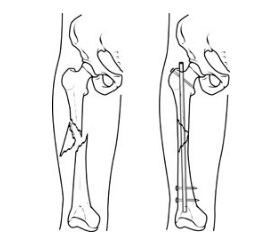What Are Fractures?
A fracture is the medical term for a broken bone.A bone may be completely fractured or partially fractured in any number of ways (crosswise, lengthwise, in multiple pieces. They occur when the physical force exerted on the bone is stronger than the bone itself.
Your risk of fracture depends, in part, on your age. Broken bones are very common in childhood, though children’s fractures are generally less complicated than fractures in adults. As you age, your bones become more brittle and you are more likely to suffer fractures from falls that would not occur when you were young.
Types of Fractures
Bones are rigid, but they do bend or “give” somewhat when an outside force is applied. However, if the force is too great, the bones will break, just as a plastic ruler breaks when it is bent too far.
The severity of a fracture usually depends on the force that caused the break. If the bone’s breaking point has been exceeded only slightly, then the bone may crack rather than break all the way through. If the force is extreme, such as in an automobile crash or a gunshot, the bone may shatter.
If the bone breaks in such a way that bone fragments stick out through the skin, or a wound penetrates down to the broken bone, the fracture is called an “open” fracture. This type of fracture is particularly serious because once the skin is broken, infection in both the wound and the bone can occur.
Common types of fractures include:
- Stable fracture. The broken ends of the bone line up and are barely out of place.
- Open, compound fracture. The skin may be pierced by the bone or by a blow that breaks the skin at the time of the fracture. The bone may or may not be visible in the wound.
- Transverse fracture. This type of fracture has a horizontal fracture line.
- Oblique fracture. This type of fracture has an angled pattern.
- Comminuted fracture. In this type of fracture, the bone shatters into three or more pieces.
Cause
The most common causes of fractures are:
- Trauma. A fall, a motor vehicle accident, or a tackle during a football game can all result in fractures.
- Osteoporosis. This disorder weakens bones and makes them more likely to break.
- Overuse. Repetitive motion can tire muscles and place more force on bone. This can result in stress fractures. Stress fractures are more common in athletes.
Symptoms
- A visibly out-of-place or misshapen limb or joint
- Swelling, bruising, or bleeding
- Intense pain
- Numbness and tingling
- Broken skin with bone protruding
- Limited mobility or inability to move a limb
Treatment.
All forms of treatment of broken bones follow one basic rule: the broken pieces must be put back into position and prevented from moving out of place until they are healed. In many cases, the doctor will restore parts of a broken bone back to the original position. The technical term for this process is “reduction.”
Broken bone ends heal by “knitting” back together with new bone being formed around the edge of the broken parts.
Surgery is sometimes required to treat a fracture. The type of treatment required depends on the severity of the break, whether it is “open” or “closed,” and the specific bone involved. For example, a broken bone in the spine (vertebra) is treated differently from a broken leg bone or a broken hip.
Doctors use a variety of treatments to treat fractures:
Cast Immobilization
A plaster or fiberglass cast is the most common type of fracture treatment, because most broken bones can heal successfully once they have been repositioned and a cast has been applied to keep the broken ends in proper position while they heal.
Functional Cast or Brace
The cast or brace allows limited or “controlled” movement of nearby joints. This treatment is desirable for some, but not all, fractures.
Traction
Traction is usually used to align a bone or bones by a gentle, steady pulling action.
External Fixation
In this type of operation, metal pins or screws are placed into the broken bone above and below the fracture site. The pins or screws are connected to a metal bar outside the skin. This device is a stabilizing frame that holds the bones in the proper position while they heal.
In cases where the skin and other soft tissues around the fracture are badly damaged, an external fixator may be applied until surgery can be tolerated.
An external fixator applied to a broken thighbone.
Open Reduction and Internal Fixation
During this operation, the bone fragments are first repositioned (reduced) in their normal alignment, and then held together with special screws or by attaching metal plates to the outer surface of the bone. The fragments may also be held together by inserting rods down through the marrow space in the center of the bone.
A specially designed metal rod, called an intramedullary nail, provides strong fixation for this thighbone fracture.
Recovery
Fractures take several weeks to several months to heal, depending on the extent of the injury and how well you follow your doctor’s advice. Pain usually stops long before the fracture is solid enough to handle the stresses of normal activity.
Even after your cast or brace is removed, you may need to continue limiting your movement until the bone is solid enough for normal activity.
During your recovery you will likely lose muscle strength in the injured area. Specific exercises will help you restore normal muscle strength, joint motion, and flexibility.
Bone fractures of all sorts happen all the time, and are commonly seen by physical therapists every day. Whether the fracture occurs in the femur, ankle, pelvis, clavicle or any other location on the body, immediate medical attention is required. The bone will need to be properly aligned, healed and set by a medical doctor. It will also need to be reduced, either manually or through a surgical procedure if the fracture is quite severe. Surgery may be recommended and required if the bone was shattered into multiple pieces, requiring it to be put back together in the correct place through an open reduction internal fixation surgical procedure.
A cast will often need to be worn for a few weeks, whether in the form of a hard cast or a removable cast. Once the proper healing has taken place, physicians will often refer patients who have fractured a bone to a physical therapist to help accelerate the healing process, reduce pain and swelling, and improve range of motion to get the patient back to their normal physical self.
Beginning Physical Therapy After a Bone Fracture
Physical therapy is most often incorporated into a bone fracture patient’s healing routine after sufficient healing has taken place, and the bone is properly aligned. Physical therapy will help to strengthen the bone and the muscle tissue surrounding the bone in order to help the patient regain full range of motion and independent mobility and function. After enduring a bone fracture, a patient may encounter physical therapy at various stages, depending on what their physician feels will optimize full recovery.
At the Hospital – Physical therapy can begin as early as within a hospital setting, particularly if the bone fracture was quite severe and required some form of surgery for proper repair and alignment of the bone. Physical therapists may visit these patients in the hospital, and teach the patient how to move properly while rehabilitating the injured area.
If the bone fracture occurred anywhere in the ankle, leg, knee or hip area, the physical therapist will instruct the patient how to walk properly and efficiently to help regain full range of motion, as well as how to walk with an assistive device like crutches. Simple actions, like getting in and out of a car or going up and down stairs can prove to be challenging when walking with an assistive device. Therapists will teach these patients how to perform these motions effectively while healing.
At Home – After a bone fracture patient is well enough to leave the hospital setting, physical therapy will continue in the patient’s home if they are still too immobile to leave their home to travel to a physical therapy clinic. A physical therapist will continue to assist the patient with moving around the home efficiently while using their cane, crutches, arm sling, or any other assistive device.
The therapist will also engage in a number of treatments that are comfortable for use within the home, such as joint mobilization, massage or exercise. Exercise routines will be one of the first things a physical therapist will most likely get the patient started on. Specific exercises will be assigned to the patient to help them strengthen their muscles and joints, as well as slowly improve and increase their range of motion. Weight bearing exercises can be particularly helpful to help strengthen the injured area.
The physical therapist may also assess the home environment, and ensure that there are no potential hazards while the patient regains full mobility.
In the Clinic – Patients who have had a cast or sling removed and are physically capable of going outside the home are often referred to a physical therapist by their physician to continue rehabilitating the injured site. This is important in helping the patient regain full function following a bone fracture and any surgery or other treatment to heal the fractured bones and surrounding tissue.
The patient may still be required to avoid certain weight lifting that they may have been able to do prior to the fracture – it’s important for the patient to adhere to any restrictions that their physical therapist has placed on them in order to avoid any further damage to the injured area.
In the clinical setting, the physical therapist will assess and take measurements of a variety of factors, including the following:
- Range of motion
- Strength
- Function
- Pain
- Flexibility
- Swelling
- Gait in lower extremity bone fractures
After an initial assessment and evaluation, the physical therapist will set out a treatment plan to help the patient fully recover. This treatment plan may vary in length, depending on a number of factors, including the severity of the bone fracture. Part of the therapy will involve helping the patient get over any negative effects that come with having a limb or other body part in a cast or sling, such as muscle atrophy or decrease in mobility.
The physical therapist may use a variety of modalities to help rehabilitate the injured area, such as ultrasound, TENS, hydrotherapy or electrical stimulation. Massage and mobilization may be used when scar tissue has developed. Exercise will almost always be employed when the patient is physically capable of applying pressure to the affected area. Exercise will help to develop the muscles and improve strength and mobility in and around the affected area.
Conclusion
Physical therapy is often an essential step after initial healing and assessments have been made on an injury. Physical therapy treatments and modalities can help to accelerate the healing process, and improve strength and mobility after a patient has suffered a bone fracture. It is important to perform all the actions that physical therapists recommend, both within a clinical setting and at home.
Visit Our Google + Page

Refences:
WebMD http://www.webmd.com/a-to-z-guides/understanding-fractures-basic-information
OrthoInfo http://orthoinfo.aaos.org/topic.cfm?topic=a00139
Medline Plus http://www.nlm.nih.gov/medlineplus/ency/article/000001.htm



